U.S.S. Valley Forge
- Legacy

- Mar 13, 2023
- 13 min read
Updated: Mar 21, 2023
Jump to section:



U.S.S. VALLEY FORGE
Sentinel Class Star Cruiser (Refit)
Starfleet Registry
NCC 43305-A

|  |  |  | |
|  |  |  |  | |

//Personnel structure representative of later seasons and does not include retired characters from earlier seasons of TTV//
COMMAND
OPERATIONS
ENGINEERING
TACTICAL & INTELLIGENCE
SECURITY & MACO
SCIENCE
MEDICAL & COUNSELLING
ATTACHÉS



GENERAL INFORMATION
CLASS | Sentinel [Refit] | DESIGNATION | Star Cruiser |
REFIT TIME | MINOR - 24 Months MAJOR - 10 Years | RESUPPLY TIME | 18 Months |
DIMENSIONS
LENGTH | 732.6 metres | BEAM | 288.3 metres |
HEIGHT | 96.1 metres | DECKS | 21 |
MASS | 3,755,000 metric tons | CARGO CAPACITY | 68,299 metric tons |
COMPLEMENT
CREW | 750 (200 Officers / 550 Enlisted) | CIVILIANS | 250 |
MISSION CRITICAL | 50 | EVAC. CAPACITY | 2500 |
AUXILIARY CRAFT
4 x Type 8 Shuttles
| Type 9 Class Shuttles
|
2 x Type 11 Class Shuttles
| 3 x Danube Class Runabouts
|
1 x FEPD Interceptor
| 6 x Nuhar Construct Hybrids
|
ARMAMENTS
SHIELDING | Redundant symmetrical subspace graviton shielding |
ENERGY WEAPONS | 5 x dorsal Type XV self-modulating phaser arrays 5 x ventral type XV self-modulating phaser arrays 1 x forward dual beam battery |
PROJECTILES | 6 x Mk. Q-IV Quantum Torpedo launchers Payload: 350 |
HULL | Micro-fiber reinforced ablative armour over Duranium-tritanium composite hull augmented by synthetic castrodium alloy structural members |
PROPULSION
ENGINE CONFIGURATION | GE Class X-10 M/AM Reaction Drive rated 1473 cochranes GE Class 8 M/AM Reaction Drive rated 1200 cochranes 3 x TV X9 Subatomic unified impulse reactors |
CRUISING SPEED | Warp 7.2 | MAXIMUM CAPACITY | Warp 9.96 sustained for ~8 hours |
SCIENCE SYSTEMS
SENSORS | DYN-65 Multi-band lateral sensor pallets 1 x DYN-12 Warp current sensor array |
NAVIGATIONAL DEFLECTOR | Yoyodyne 32.E Molybdenum/duranium mesh panelled subspace field amplification array |
PROBE COMPLEMENT |
|
2415 Refit
The Valley Forge has undergone a major refit to bring it in line with current requirements. The entire warp assembly has been completely replaced with the latest model. An operation which called for new nacelles to be installed, and an interior remodel to accommodate the newer, larger core. To this end, the original ventral shuttlebay has been reworked to accommodate the new core, and two new vertical launch shuttlebays have been retrofitted to the port and starboard dorsal engineering section. The most significant refit however comes to the saucer section, as it is rebuilt to accommodate separation. The new independent saucer has low warp capability from it's tertiary nacelles which remain concealed below armoured hull sections when not in use..
Other areas of improvement include replaced sensor arrays and main deflector dish, a completely rebuilt bridge and new laboratory facilities. The overall refit has been completed with minimal sacrifice of the vessel's former battle capability as se retains a standard dorsal/ventral phaser array, four foreward torpedo bays and two rear, in addition to an upgraded dual beam bank on the nose of the saucer.
Post-Refit Field Modifications
Many Starfleet vessels are subjected field modification at the hands of their crews during active service, and the Valley Forge is no exception. As her post-refit Commanding Officer is of an engineering background, all modifications have been carried out with a strict adherence to ASDB design protocols and logged accordingly:
Shortly after the ship was commissioned, Captain Se'Lai subjected the vessel to rigorous field assessment to stress test the refit systems. This highlighted oversights in the integration of the secondary warp core which were resulting in gross efficiency losses throughout the EPS grid. Extensive modification to the entire warp assembly and power systems was carried out during her first few months out of drydock and the combined power system was eventually stabilized at 102.53% of design power efficiency, resultant from the design & integration of a Power Inversion Unit (Step-Down).
Further post-shakedown field modification was implemented by the crew to utilize the rebalanced EPS grid to accommodate full time running of the saucer impulse reactor. With minor hull modifications to install exhaust ports for the docked position, this introduced the maneuverability benefit of having both port and starboard impulse drives running from the forward 1/3 of the ship (as noted during shakedown, the initial single output drive at the stern was less than optimal for combat maneuverability). By angling the new exhaust ports at ~30 degrees from the ventral axis, sublight maneuverability was increased exponentially by 307.4%, requiring retraining of helm operators to accommodate what is commonly considered a responsiveness more akin to a smaller escort class, certainly not one which is normally associated with the pre-refit 'Space Whale' Sentinel variants.
Resulting from severe combat damage less than a year out of drydock, the main bridge was completely overhauled to Captain Se'Lai's personal specifications. This included reinforced bulkheads to the ceiling dome - increasing deck 1 structural integrity by a factor of 3.2 from design criteria. The added reinforcement reduced overall room size which was accommodated by lowering the central bridge; which reportedly improved command station visibility around the room and of the viewscreen. Additional emergency systems were also incorporated into the refit including additional escape pods - vertically mounted within the outer spaceframe - rehousing of the bridge armoury lockers to a central position within the lowered central section, and integration of the latest LCARS patch to allow more fluid station allocation.
The lateral sensor palettes have been periodically adjusted in reaction to field conditions. Although the specific reason for such extensive upgrade has been glossed over, the results demonstrate long range improvement to 117.8% of design specification, and short range resolution increasing 124% of design specification (comparatively equivalent to the specified sensor capacity of a standard Pathfinder class).
The navigational deflector array has received regionally ordered upgrades to accommodate countermeasures against weapons of the Azedi Confederacy. It was further modified to allow the Valley Forge to open an artificial wormhole first created by the Azedi, although this upgrade reportedly included a self-destruction protocol which saw the upgrade remove itself shortly after the mission was completed.
Shield emitters have been upgraded with improved protocols developed in conjunction with the OSN specifically as a defense against the EereE-adapted deflector burst technology which had proven to bypass standard shield configurations. NB: Valley Forge was the first vessel to utilize this modification as it participated in the R&D trials before protocols were rolled out across the fleet.
Internal modification has been made to the Captain's quarters to increase to that of a family complement. Reports indicate the redesign was optimized by a future ASDB candidate to allow the required internal volume increase whilst avoiding intrusion into adjoining sections. This was achieved by rerouting a section of the EPS grid reallocating shared systems within the adjoining void into those on decks immediately above and below. Numerous other crew quarters have reportedly been modified to accommodate personal requirements of the specific crew, including that of the Chief Engineer.
Small craft complement has increased with the addition of a single 'Eon' Interceptor, allocated to the Valley Forge as part of an officer exchange program with the Human residents of a recently discovered colony. The Eon is a single occupant short range defensive vessel and though it does not currently possess warp capability, it's sublight drive is capable of maximum speeds in excess of the Valley Forge's full impulse velocity. Initial engineering reports also indicate that the Eon's power cell is a new technology for it's people and is initially estimated to be running at a fraction of it's potential efficiency. This may accommodate future development of the small craft itself to allow warp capability.
2420 Arshai Refit

From Captain Se'Lai's associated AAR: With thanks to the accommodations made by the Colonial Fleet in use of their drydock and the provision of support staff to carry out the work, the Valley Forge's second major refit has been successfully completed, with all recent battle damage restored to Starfleet specifications. New upgrades have also successfully been installed and tested as follows:
Neutronium hull plating: A thin layer of reconstituted neutronium has been coated around the outer hull(s), reworked at Arshai facilities from salvaged raw material originally belonging to the Nuhar construct - Wanderer. Though the original construct was comparable in size to the Valley Forge. The salvage and refinement process reduced the workable quantity significantly so, making it impractical to attempt a complete hull replacement at this time. While the fine layer adds no significant armouring to the hull, it's natural properties to serve in scattering sensor beams and making the Valley Forge interior impervious to sensor scans.
Ablative armour nano-generators: Building on existing Starfleet designs with the technology of Olelian replication added, this system holds and deploys Olelian nanites from strategically placed housings around the outer hull (which have been more seamlessly integrated into the hull plating than the original generator design, sported by USS Voyager). This alternative method means that deployment power and time costs are exponentially reduced, and that the ablative layer is much more reactive to vessel conditions. Further development of localized shield generators to automatically deploy around opening weapon & hangar ports is currently under investigation.
Transporter scattering field: This has been developed through the implementation of a tertiary shield matrix which is routed throughout the inner hull using a distribution system based on the interplexing distribution nodes used on Borg vessels. The node system allows for effective power distribution without exerting heavy additional strain on reserves, meaning that the system can remain active in the background and not require direct activation and power shunt like the combat shield grids. Coupled with the neutronium hull plating, the intention of this development is to secure the Valley Forge against boarding by more advanced hostile species; which has occurred an unacceptable number of times in this officers command.
Point defense system: automated - short range - turret heads have been mounted at strategic positions around the hull of the ship. Activating alongside tactical systems, this system tracks and eliminates small craft & projectiles moving at too close a range and too high speed for standard weapons targeting to be effective. It can also be manually overridden to provide blanket suppressing fire, as recommended from the FEPD from their greater experience with small craft deployment, this option should allow greater security to combat deployment of small craft.

Stardate 51932.7 | The original USS Valley Forge (NCC 43305) was a 24th century Federation Excelsior-class starship operated by Starfleet. The Valley Forge fought in the Dominion War and, in late 2374, saw action at the First Battle of Chin'toka. She took heavy damage during an attack run against Cardassian orbital weapon platforms when a crippled Akira-class starship crashed into her starboard nacelle, followed by several disruptor hits that penetrated her primary hull.
Stardate 62464.9 | The Valley Forge was recommissioned as a newly constructed Sentinel Class Star Cruiser (NCC 43305-A) and pressed into service. During her tenure, the Valley Forge saw extended service ranging from border patrols and diplomatic duties to frontline assignments during periods of conflict, until late 2413 when she was drydocked for a complete refit.
Stardate 92773.8 | The newly refitted Valley Forge is released from drydocked and assigned to Gemini Squadron of the 38th Fleet Argo, under the command of Captain Keelah Se'Lai.
Stardate 92843.3 | Transferred to the newly formed Libra Squadron as part of the 38th structural reorganisation.
Stardate 93745.5 | USS Valley Forge spearheaded S&R operations to locate the missing crew of the USS Gainsborough after she was lost along with her entire task force to a negative first contact with species 2492.
Stardate 94052.2 | Following extensive combat damage to the saucer section; the main bridge was completely refitted per Captain Se'Lai's personal specifications providing additional bulkhead reinforcement and integrated emergency systems.
Stardate 94267.2 | Reassigned to the 38th Fleet's Aries Squadron following local command review of fleet logistics.
Stardate 94845 | Supported evacuation operations during the battle of DS13.
Stardate 95108.4 | Participated in the Forged Earth 'Landing Day' anniversary celebration, in place of honour
Stardate 96376.7 | Transferred to DSEC and assigned to the long range exploratory mission beyond the mapped borders to locate the perceived Dyson sphere near the galaxy's edge, which connects to the gateway found in the Forged Earth system.
Stardate 97252.8 | Received second major overhaul at the Arshai colony: Vue En
Stardate 97271.9 | Chosen Empire title 'Tarros' (meaning Honoured Guest) bestowed upon the Valley Forge and it's crew
LEGACY OF THE FORGE [Pre-Warp]
U.S.S. Valley Forge CV-45 [1946-1970]


USS Valley Forge (CV/CVA/CVS-45, LPH-8 ) was one of 24 Essex-class aircraft carriers built during and shortly after World War II for the United States Navy. The ship was the first US Navy ship to bear the name, and was named after Valley Forge, the 1777–1778 winter encampment of General George Washington's Continental Army. Valley Forge was commissioned in November 1946, too late to serve in World War II, but saw extensive service in the
Korean War and the Vietnam War. She was reclassified in the early 1950s as an attack carrier (CVA), then to an antisubmarine carrier (CVS), and finally to an amphibious assault ship (LPH), carrying helicopters and marines. As a CVS she served in the Atlantic and Caribbean. She was the prime recovery vessel for an early unmanned Mercury space mission. After conversion to an LPH she served extensively in the Vietnam War. Valley Forge was awarded eight battle stars for Korean War service and nine for Vietnam War service, as well as three Navy Unit Commendations. Although she was extensively modified internally as part of her conversion to an amphibious assault ship, external modifications were minor, so throughout her career Valley Forge retained the classic appearance of a World War II Essex-class ship. She was decommissioned in 1970, and sold for scrap in 1971.

Earth date: 3rd November 1946 | Commissioned from the Philadelphia Naval Shipyard
Earth date: 1947-1950 | Conducted round the world shakedown cruise
Earth date: 1950-1954 | Deployed to Korean War and became flagship of the United States Seventh Fleet
Earth date: 1954-1960 | Redeployed as CVS-45 with the Atlantic Fleet
Earth date: 1959 | Designated as flagship of Task Group ALFA
Earth date: 1961-1964 | Refresher training
Earth date: 1965 | Redeployed to the Vietnam War
Earth date: 15th January 1970 | Decommissioned
U.S.S. Valley Forge CG-50 [1984-2004]
CG-50 was a Ticonderoga-class cruiser in the United States Navy. She was named for Valley Forge, where the Continental Army camped during one winter in the American Revolution.


Earth date: 29th September 1984 | Commissioned from Ingalls Shipbuilding in Pascagoula, Mississippi
Earth date: 1986 | Participated in RIMPAC naval exercises
Earth date: 2003 | Assigned to Destroyer Squadron
Earth date: 31st August 2004 | Decommissioned
Earth date: 2006 | Sunk as target practice
U.S.S. Valley Forge LPH-8 [2021-2062]


USS Valley Forge (CVA-78, LPH-8 was a Hercules class carrier commissioned in the early years of the third world war. She saw a dignified retirement after the close of the war in 2053 as a training vessel.
Valley Forge [circa 2150]

The first space vessel to carry the Valley Forge name was an early attempt at interplanetary colonization. She launched from Earth in the mid 22nd century at sub-warp speeds, but never reported arrival at her destination.
Found to have survived anomaly transit when descendants of the ship were encountered by USS Valley Forge NCC 43305-A in late 2417
LEGACY OF THE FORGE [Warp era]
U.S.S. Valley Forge NCC 181 [21929.1]

The first warp capable vessel to carry the Valley Forge name in Starfleet was this Daedalus class variant; lost at the Battle of Berengaria after engaging Romulan warships during the battle.
U.S.S. Valley Forge NCC 1463 [30287.3]
USS Valley Forge (NCC 1463) launched in November of 2226 [Stardate 302876.3]. Unlike preceding cruiser classes, Valley Forge was not the result of a design competition. Because of the numerous irregularities that had marred the Lancaster competition of 2203, Starfleet announced in 2206 that henceforth the design and construction of all military vessels were to be "Federalized." Instead of Starfleet issuing a set of design specifications and inviting submissions from private firms, all design work and construction was to be concentrated at soon-to be expanded Starfleet yards, the first of which was to be in geosynchronous orbit above San Francisco, Earth. Therefore, by the time work began on Valley Forge, several classes of smaller vessels had already been produced at Starfleet Yards throughout the Federation.

Visually, the slim, refined lines of the Valley Forge class were a distinct change from the massive, blocky silhouette of the Lancaster class. However, the basic starship layout that had been established by the Daedalus class of 2160 was continued. Furthermore, the follow-on Constitution class of 2245 was so similar in appearance to the Valley Forge class that when the USS Constitution first entered service, she was compared to a "Valley Forge on steroids."
Although the Valley Forge class was not intended to break any new ground in terms of design or technology, it did introduce several now-standard features. Valley Forge ships were equipped at launch with a "modern" battery limited to phasers and photon torpedoes. Neither lasers nor fusion weapons were carried. Because the man-rated transporters had become the principal means of ship-to-shore and ship-to-ship personnel travel, the ship's complement of shuttlecraft was reduced. Furthermore, fighter/attack craft and landing craft were now carried only by dedicated shuttlecarriers and assault transports. Valley Forge ships were the first to have a completely separable primary hull that was capable of independent action, although this capability was never used. Compact, spherical fusion reactor chambers were used instead of the cuboid reactors that had been standard in earlier classes. Finally, Valley Forge ships were the first to have duotronic computer systems installed in 2243.


U.S.S. Valley Forge NCC 1732 [35145.2]

NCC 1732 was a Constitution Class cruiser - built to the refit Mk I standard. She saw active service through the late 23rd century.
U.S.S. Valley Forge NCC 1778-A [37045.2]

NCC 1778-A was the immediate successor to the Constitution class 1732. This incarnation of the Valley Forge appeared to be Constitution-class variant. The primary hull, warp nacelles and torpedo launcher, amongst other components, were configured in a design similar to its contemporary, the smaller Oberth-class. The type was armed with phaser banks and photon torpedo.launchers.
U.S.S. Valley Forge NX 41200 [43604.5]

The legacy of the Valley Forge as a fleet pioneer continued into the 24th century with it's incorporation into the experimental development phases of the Iwo Jima-class. However this variant did not see extensive active service.
U.S.S. Valley Forge NCC 43305 [46043.5]

The Valley Forge was restored to an active service role with the commissioning of the Excelsior class NCC 43305.

The vessel saw extensive service during the Dominion War until she was damaged beyond repair during the Federation invasion of the Chin'toka system where a collision with an out of control Akira class vessel saw irreparable damage caused to the Valley Forge's starboard nacelle and primary hull. This led to the vessel being decommissioned shortly afterwards.
Keelah's Ready Room | USS Valley Forge

In terms of layout, the room is very much as seen with the Voyager bridge
; with her desk set across from the door and a step up to a raised half of the room on one side which looks out over the hull of the ship. The decor is sleek but minimalist with a curved white desk & office furniture, all of which is offset with darkened trim. The rest of the room follows this crisp style with soft white leather seating curved across the front of the window and minimal furniture accompanying it (at one end of the long window sofa is a fluffy pillow which looks well used and very bedded in with cat hair, though the accompanying cat never seems to be around...). The darkened floor is bare throughout most of the room, trimmed to match the personal decor, though the area immediately in front of the group seating by the window hosts a large thick white rug to match the rest of the suite.
Desk Area
Though the most notable feature to greet visitors is the large metallic IDIC sculpture adorning the wall behind it, the desk itself is generally as minimalist as the rest of the room; with the distinct appearance that everything has it's place and is sited just so. Keelah's console sits centrally at it, usually with a small stack of PADD's to one side. There is often a small pot next to a steaming mug of Vulcan spiced tea on the opposite side of the desk to this.

Behind the desk however, sit a few books and ornaments on a shelf - next to a Bajoran prayer idol which appears to be well used - and the keener eyed visitors would even spot a curious small green bottle with what looks like an IDIC symbol on it as well.

Sat on the shelf beyond the few books that appear to be seldom used, are a pair of silver photo frame adorning pictures of Keelah on her wedding day, and of her daughter T'Pia - the wedding picture also has a small golden pendant draped over one corner; a long narrow piece with Egyptian hieroglyphs on it. These pictures sit in front of a Vulcan meditation lamp which appears as unused as the books nearby.
Around the Room

The replicator alcove beside Keelah's desk - for those fortunate enough to catch a glimpse - also houses a curious crude & colourful drawing of a starship made by her daughter at a young age, as well as a pristine glass wall mount containing a collection of service medals.
The wall opposite Keelah's desk - adjacent to the corner doorway - proudly displays a collection of pencil sketches depicting vessels to historically carry the same name - as drawn by her XO, CMDR Zh'Zhavis - each with a small plaque beneath detailing the service period and registry of each ship, and next to this collection is a smaller glass frame with a collection of accompanying ship patches including those of the various squadron assignments the current Valley Forge has served with. While the opposite wall is mostly plain, it is fronted by a pair of neatly trimmed plants on the floor which seem to flank a raised glass enclosure containing a model Sovereign class starship; it's plaque reads 'USS Legacy'. High on the wall above this, an ornamental lirpa hangs at a slight - though seemingly very purposefully calculated - angle









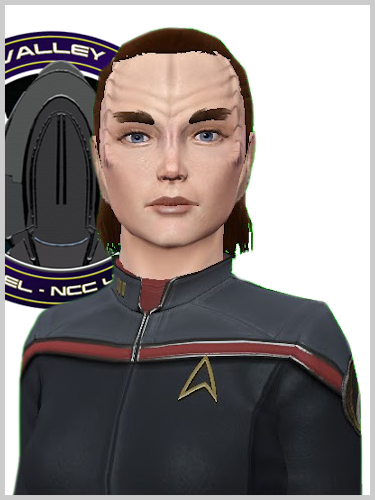












































































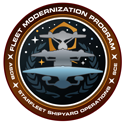
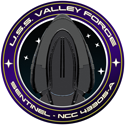
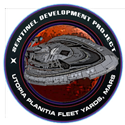









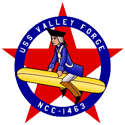

























I didn't make this post so I'm not biased! It's actually the most detailed and impressive ship dossiers we have though, so it deserves the 5 stars!
I'm not biased...